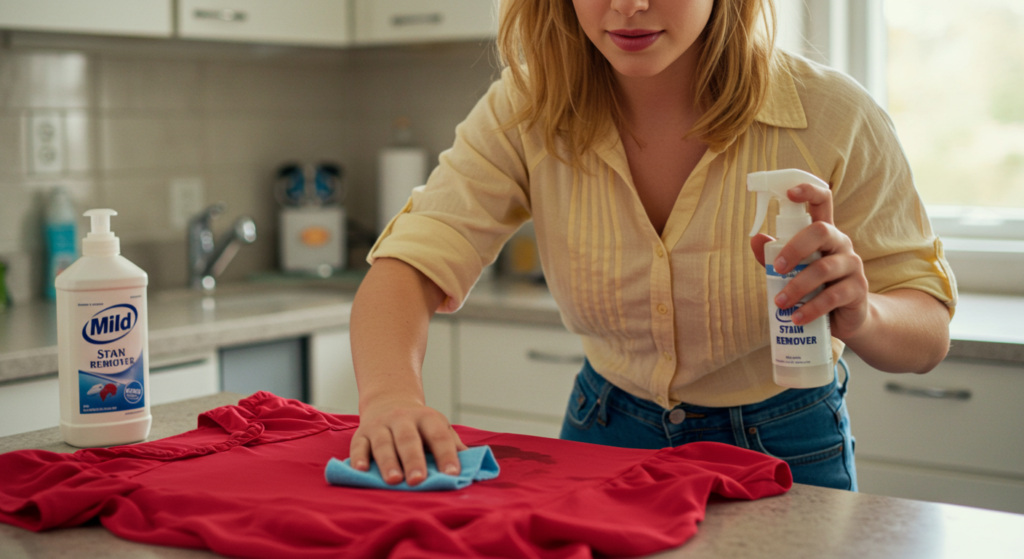Key Takeaways
- Proper sorting of clothes prevents color bleeding and preserves vibrancy.
- Pre-treating stains and checking colorfastness ensures your garments look fresh.
- Adapting your washing, drying, and ironing methods to each fabric type extends longevity.
- Out-of-the-box storage solutions help you keep colored clothes neat and photo-ready.
- On-the-go maintenance tips protect colored garments while traveling or in everyday routines.

Introduction
Caring for colored garments requires more than simply tossing them in a washing machine. Whether you own a rainbow-hued wardrobe or prefer subtle pops of color, your clothing demands a proactive approach. From choosing a color-safe detergent to organizing your closet in creative ways, each detail plays a crucial role in preserving brilliance.
This guide is an all-encompassing resource for anyone looking to enhance the lifespan of vibrant apparel. It addresses what happens in the laundry room, how to store and refresh clothes at home, and the special attention required for delicate fabrics. You’ll learn pro tips to keep those blues, reds, and greens looking crisp, prevent fading, and ensure your clothing always makes the statement you intended.
Below, you’ll find 14 sections, each with three subsections, designed to answer every question about maintaining colored garments. Expect to find everything from sorting secrets to specialized stain removal hacks, as well as mindful strategies for daily wear. Keep this guide handy, and watch your colorful wardrobe remain as bright as the day you bought it.
Smart Sorting Strategies

The Importance of Sorting
A core aspect of garment care begins with sorting clothes by color. Combining vibrant reds with lighter pastel shirts can invite unwanted color transfers. By grouping similar tones, you can reduce the risk of color bleeding and ensure that garments retain their original hue.
- Bright vs. Dark: Separate bright colors (think neon or bright jewel tones) from darker shades like navy, burgundy, and black.
- Light Colors Together: Whites and pastels stay safest when washed together, especially if you use a gentle detergent.
- Multicolored Prints: If a piece contains many colors, opt to wash it with the darkest color family present in the pattern to minimize any accidental bleeding.
Sorting by Fabric Type
Sorting shouldn’t be limited to just colors. Textile type also matters in order to retain color intensity and overall fabric integrity. A heavier cotton jean can rub up against a delicate chiffon blouse, causing friction or snags.
- Heavy vs. Delicate: Group bulky items (denim, sweatshirts) separately from finer garments (silk, satin).
- Synthetic vs. Natural: Polyester and nylon have different wash settings than cotton or linen, so splitting them accordingly helps you use the ideal water temperature and spin cycle.
- Knit vs. Woven: Knitted fabrics can stretch if tossed with stiff, woven fabrics. Keeping them separate reduces pulls and tears.
Colorfastness Test
Not all garments are created equal. Before you toss that newly bought, vivid shirt into the machine, test its colorfastness. Wet a small area (like a hidden seam) with water and dab it gently using a white cloth. If the cloth picks up dye, you know you have a garment prone to bleeding.
- Step-by-Step: Dampen, blot, check for residue.
- When to Test: Any new or suspect garment.
- Preventive Wash: If color runs during the test, consider hand-washing it separately or use a color-catcher sheet.
The Right Washing Methods
Temperature Control
Your laundry temperature decisions affect both color vibrancy and fabric longevity. Extremely hot water can break down fibers and fade colors, whereas ice-cold water sometimes fails to remove certain stains thoroughly.
- Cold Water for Most Colors: A cooler setting helps preserve brightness and is more eco-friendly.
- Warm Water for Stubborn Stains: Some heavily soiled items need lukewarm cycles.
- Check Labels: Manufacturer tags often specify the recommended wash temperature to protect color and fiber.
Cycle Settings
Today’s washing machines come with a variety of cycle settings that offer targeted care for specific items. If your clothes can handle normal agitation without risk, go for it. But if you’re dealing with delicate garments, a gentler cycle is best.
- Permanent Press: Reduces wrinkles, uses a cool-down cycle, and is moderate on fabrics.
- Gentle/Delicate: Slower spin, less agitation—ideal for sheer materials prone to color loss.
- Hand Wash Cycle: An ultra-gentle setting, perfect for garments labeled ‘hand wash only.’
Color-Safe Detergents
Not all detergents are equal. When you’re washing colored garments, select a detergent labeled “color-safe.” These formulas feature milder cleaning agents that target dirt without stripping away dye molecules.
- Liquid vs. Powder: Liquid detergents often dissolve more uniformly, reducing residue that can dull colors.
- Optical Brighteners: Some detergents contain chemicals that enhance brightness—great for lighter-colored garments, but check if it’s safe for all fabrics.
- Eco-Friendly: Plant-based solutions can be kinder to certain dyes and the planet, though always verify compatibility with synthetic fibers.
Stain Removal Hacks

Spot-Treating Colors
Stains are inevitable, but color fade doesn’t have to be. Spot-treating is all about tackling blemishes before they set. The key is swift action.
- Act Fast: The quicker you apply a stain remover or mild soap, the higher your chances of saving the fabric’s color.
- Blot, Don’t Rub: Rubbing grinds the stain deeper into fibers. Blotting lifts it without causing friction.
- Rinse Inside Out: Run cold water from the backside of the stain to push it outward, instead of deeper into the fabric.
Homemade Remedies
Commercial spot cleaners are helpful, but homemade solutions also get the job done when used wisely. A gentle paste of baking soda and water can help lift stubborn marks without bleach.
- Mild Dish Soap Mix: A few drops of dish detergent in warm water can remove oil-based stains.
- White Vinegar & Water: Great for tackling mild yellowing on underarms or collars, though test the colorfastness first.
- Hydrogen Peroxide Caution: Useful for certain stains on lighter colors, but it can lighten darker fabrics.
Specialized Stain Products
Some stains need an extra nudge. Color-friendly bleach alternatives and enzyme-based products work wonders without draining color from the rest of the garment.
- Oxygen-Based Brighteners: Revive color without the harshness of chlorine bleach.
- Enzyme Soaks: Break down organic stains like sweat, grass, or food, preserving the original hue.
- Pre-Wash Sprays: Apply directly to the spot and let it sit for a few minutes before loading the wash.
Drying Done Right
Line Dry vs. Machine Dry
Heat can be a color’s worst enemy. Line drying is often the safest method to maintain the vibrancy and shape of a garment. However, not everyone can line-dry year-round.
- Outdoor Line Dry: Sunlight can fade clothes, so turn them inside out. Choose a shady but breezy spot if possible.
- Indoor Line Dry: Use a foldable rack to reduce direct sunlight exposure while still allowing air circulation.
- Machine Dry: Choose the lowest heat setting possible, or consider an “air dry” cycle to reduce friction.
Drying Rack Techniques
A drying rack offers an in-between solution if you don’t have ample outdoor space. To optimize drying efficiency:
- Flat Dry Delicates: Lay delicate sweaters or knit tops flat on a mesh rack to prevent stretching.
- Spread Items Evenly: Overlapping clothes can create moisture pockets that lead to musty smells or blotchy color.
- Flip Heavier Items: Jeans or heavy cotton might dry slowly on one side; flipping them halfway helps.
Avoid Overdrying
Overly dry garments become stiff and prone to fading. Controlling the final moisture level can make a big difference in color preservation.
- Check Mid-Cycle: If machine drying, pause halfway to see if garments are already dry.
- Slight Dampness is Good: Removing clothes just before they’re bone-dry helps fibers remain supple.
- Air Out Creases: A short fluff cycle in the dryer followed by some time hanging can reduce wrinkles without exposing fabric to excess heat.
Ironing and Steaming Tips

Understanding Heat Settings
Ironing colored garments can keep them crisp, but you have to set the right temperature to avoid scorching or dulling the color.
- Low to Medium Heat: Choose a lower setting for delicate fabrics (silk, rayon) and medium for cotton or linen blends.
- Steam or Spray: Moisture makes ironing easier, reducing the need for high heat.
- Always Check Labels: Some materials (like poly-blends) can melt if the iron is too hot.
Inside-Out Ironing
If ironing on the face of the fabric, direct contact might leave shiny patches or flatten texture. Turn garments inside out to protect the color and surface finish.
- Cover with a Pressing Cloth: Use a thin, clean cotton cloth between the iron and garment for extra safety.
- Focus on Seams First: Press seams and edges carefully, then move on to the central areas of the garment.
- Be Gentle with Prints: For printed designs, pressing on the reverse side prevents cracks in the graphic.
Steaming for Color Care
A clothes steamer offers a gentler approach. Steaming can release wrinkles without direct heat contact, preserving color vibrancy.
- Suitable for Delicates: Silk, satin, and synthetic blends respond well to steam, reducing potential color fade.
- Vertical Steaming: Hang the garment on a sturdy hanger and steam from top to bottom in slow motions.
- No Pressing Needed: Simply let gravity help loosen wrinkles, saving your garment from friction.
Closet Organization Essentials
Color-Coded Hanging
A tidy closet contributes to longer-lasting garments. Color-coding your wardrobe can also help you track what needs more frequent laundry.
- Arrange by Shade: Keep reds together, blues together, and so on to limit friction and color transfer.
- Seasonal Segmentation: Separate heavier, darker pieces from light, bright ones to optimize usage and care.
- Use Non-Slip Hangers: Padded or velvet hangers keep clothes from sliding around and rubbing color onto each other.
Folding vs. Hanging
Not all garments benefit from being on a hanger. Knowing when to fold or hang can keep your colored garments looking brand-new.
- Fold Knits and Sweaters: These items can stretch on hangers, leading to shape loss and color stress points.
- Hang Woven Shirts: Blouses, button-downs, and dresses can hang without losing shape, reducing ironing needs.
- Stack by Weight: Heavier folded items on the bottom, lighter ones on top, to prevent smothering delicate fabrics.
Protective Storage
Sometimes you need to store rarely worn or off-season garments. Using the right protective storage techniques keeps away dust, humidity, and color fade.
- Breathable Garment Bags: Canvas or cotton garment bags allow air circulation and protect garments from dust.
- Acid-Free Tissue Paper: Wrap delicate items in tissue paper to prevent color transfer and reduce wrinkles.
- Avoid Plastic Wrapping: Plastics can trap moisture and cause mildew, affecting both color and fabric quality.
Off-Season Care
Seasonal Rotation
Keeping your closet relevant to the current climate helps you focus on caring for the clothes you actually wear. Seasonal rotation is a simple concept: store away what you don’t need until the weather changes.
- Clean Before Storing: Wash and thoroughly dry garments to prevent mildew and insect damage.
- Label Boxes or Bins: Knowing exactly where you placed your bright summer dresses or winter fleeces saves time later.
- Vacuum-Sealed Bags Caution: While they save space, extended compression can stress certain fabrics and fade dyes.
Refresh Before Rewear
When that season rolls around again, it’s tempting to pull out stored items and wear them right away. However, a quick refresh ensures your clothes are in top condition.
- Air Them Out: Even if you stored them clean, a few hours in fresh air or near a fan can lift any stale smell.
- Light Steaming: Eliminates wrinkles and revives the fabric without the need for a full wash.
- Check for Damage: Inspect seams, hems, and any discoloration before wearing again.
Pest Prevention
Moths and other insects can do surprising damage to colored clothes. Implement pest prevention strategies to avoid patchy damage or holes.
- Cedar Blocks or Lavender Sachets: Natural repellents that keep your storage smelling pleasant.
- Avoid Damp Places: Basements or attics with fluctuating humidity might encourage mold or insect activity.
- Regular Inspection: Keep an eye on stored clothing for any signs of pests or mold development.
Delicate Fabrics and Special Finishes

Silk and Satin
Silk and satin add luxury to your wardrobe but need extra care to maintain their brilliant sheen. One slip-up with laundry methods can dull the color.
- Gentle Detergent: Use a mild detergent specifically formulated for delicate fabrics.
- Hand Wash or Delicate Cycle: If you trust your machine’s delicate setting, place items in a mesh bag for added protection.
- No Direct Sun: Dry these items away from sunlight to keep dyes from bleaching out.
Velvet and Velour
Soft to the touch and visually lush, velvet and velour can quickly lose luster if not cared for correctly. The pile (the raised fibers) needs gentle handling.
- Air Out After Wear: Let the fabric breathe to release trapped moisture and maintain softness.
- Spot Clean First: If you get a spill, gently blot with a dry cloth before resorting to deeper cleaning.
- Steam to Fluff Fibers: Instead of ironing, steam from a short distance to restore the pile.
Embellished Garments
Beads, sequins, or embroidery can bring an extra pop of color and texture, but these details are also more fragile.
- Hand Wash Recommended: Whenever possible, hand wash with minimal agitation.
- Inside a Laundry Bag: If machine washing is unavoidable, a mesh bag can protect delicate embellishments.
- Hang or Lay Flat to Dry: Avoid any tumbling, as high-speed spinning can snag or loosen the adornments.
Denim Dynamics
Retaining Denim Color
Denim is a wardrobe staple that can fade quickly if washed incorrectly. Lock in the indigo by turning jeans inside out and using a cool cycle.
- Vinegar Trick: Some denim lovers add a cup of white vinegar during the rinse cycle to help set the dye.
- Minimal Washing: Spot-clean between full washes to reduce stress on fabric and color.
- Air Dry Always: Heat from a dryer can suck the life out of denim color, so hang them up if you can.
Avoid Color Transfer
Dark denim can rub off on light-colored garments or even upholstery. To minimize color transfer, consider these tips:
- Wash New Jeans Separately: Especially if they have a deep, rich dye, they can bleed for the first few washes.
- Wear Dark Denim with Similar Shades: If you’re wearing a new pair of indigo jeans, pair with darker tops and jackets.
- Carry a Color Catcher: In the first few washes, pop a color-catcher sheet in the machine to soak up excess dye.
Denim Care Innovations
If you’re worried about fading but also want fresh-smelling jeans, there are some out-of-the-box methods:
- Freezer Freshening: Place jeans in a sealed bag and put them in the freezer overnight to kill bacteria without washing.
- Steaming in the Shower: Hang your jeans in the bathroom while you shower to loosen wrinkles and refresh them.
- Spot-Cleaning Paste: A mild dish soap and baking soda mix can handle small stains without a full wash cycle.
Outdoor and Sportswear
Preserving Activewear Colors
Workout clothes and athleisure items often feature neon prints or unique designs. Preserving these bold hues means handling synthetic blends carefully.
- Cold Water Wash: Heat can weaken stretch fabrics like spandex or lycra and fade those bright colors.
- Skip Fabric Softeners: They can coat the fabric, reducing moisture-wicking properties and dulling color.
- Air Dry Flat: Elastic fibers can warp in high heat, so skip the dryer if possible.
Removing Sweat Odors
Colored sportswear often retains sweat odors more than casual cotton tees. Advanced odor removal can keep them fresh without harming the garment’s color.
- Vinegar Soak: A quick soak in a mixture of water and white vinegar helps break down odor-causing bacteria.
- Baking Soda Pre-Treatment: For stubborn smells, sprinkle a bit of baking soda and let it sit before washing.
- Enzyme-Based Detergents: Target bacteria and organic compounds responsible for foul odors.
UV Protection and Color Fade
Activewear used outdoors faces intense sunlight, which may bleach out your favorite colors. Simple measures can go a long way.
- Sunscreen for Garments?: Some manufacturers offer UV-protective sportswear. If that’s not an option, at least line dry them in the shade.
- Rinse After Beach or Pool: Saltwater and chlorine can speed up color fading.
- Rotate Your Activewear: Having multiple sets ensures you’re not over-laundering the same items repeatedly.
Traveling with Colored Clothes

Packing Strategies
Traveling can be tough on garments if you’re not prepared. Strategic packing keeps wrinkles and color bleeding in check.
- Separate Light and Dark: Use packing cubes or bags to separate bright-colored clothes from darker items.
- Bundle Rolling Technique: Rolling clothes reduces creases and helps you see everything at a glance.
- Plastic Bags for Shoes: Keep potential dirt away from delicate colors by bagging your footwear.
Quick Touch-Ups
It’s no fun unpacking to discover your outfits look dull or wrinkled. Keep a travel-friendly care kit on hand.
- Mini Steamer or Wrinkle-Release Spray: Perfect for smoothing out wrinkles without needing an iron.
- Portable Stain Stick: Swiftly treat unexpected spills while on the go.
- Color-Catcher Sheets: If you must do laundry mid-trip, these sheets can safeguard your clothes from color mishaps.
Post-Trip Revitalization
After returning home, your clothes might be crumpled or carry odd odors. Revitalize them with a few steps:
- Unpack Immediately: Letting them fester in a suitcase can cause wrinkles and mustiness.
- Sort for Washing: The rules of color sorting still apply to your post-travel load.
- Full Refresh Cycle: For items that only need deodorizing, use a short cycle with color-safe detergent.
Daily Wear and Tear
Rotation of Favorites
Wearing your top picks too frequently can cause quicker fade. Rotating your clothes evenly spreads out wear and tear.
- Create a Weekly Lineup: If you’ve got multiple favorites, plan them out so each gets a break between wears.
- Mix and Match: Combine different garments to vary stress points and avoid friction in the same spots.
- Extend Washing Intervals: Some garments (like jackets or jeans) might only need a wash after a few wears.
Minimizing Friction
Friction from belts, bags, or even the seat of your chair can cause rubbing and discoloration.
- Mind Your Handbag Strap: If you carry a shoulder bag daily, that area might wear out faster. Switch shoulders often or rotate bag styles.
- Avoid Rough Surfaces: Leaning on abrasive counters or walls can thin fabric and dull color.
- Choose Softer Accessories: Scarves, wraps, or cloth belts can help reduce friction compared to stiffer materials.
Spot Cleaning Between Washes
Frequent washing shortens garment life and can fade color. Spot cleaning is an excellent alternative.
- Tackle Localized Marks: A quick dab with mild detergent can handle small spills, reducing the need for a full wash.
- Air Out to Freshen: Hang worn items in a well-ventilated area to let any odors dissipate.
- Fabric Spray: A light fabric refresher spray can neutralize smells without soaking the entire garment.
Eco-Friendly Approaches
Gentle Detergent Choices
Eco-friendly doesn’t mean sacrificing color vibrancy. In fact, many plant-based detergents are gentler on dyes.
- Low Suds, High Efficiency: Concentrated formulas allow better rinse cycles.
- Biodegradable Ingredients: Protect the environment while preserving your garments.
- Recycle Packaging: Opt for refill stations or brands with recyclable containers.
Water and Energy Conservation
Saving resources can also protect your colored clothes since gentler settings and cooler water reduce fading.
- Wash Full Loads: Maximize each cycle to conserve water, but don’t overstuff to the point of friction.
- Cold Cycles: Most modern detergents work well in cold water, cutting energy usage.
- Shorter Cycles: Quick wash settings might be enough for lightly soiled colored garments.
Sustainable Fabric Care
Taking a holistic approach to your garment care can extend color life and be kinder to the planet.
- Natural Drying: Sun is free, but remember to turn clothes inside out or use shaded spots.
- Mend and Patch: If a seam frays or a button comes loose, fix it before it worsens and risks color fading in the wash.
- Choose Quality Over Quantity: Higher-quality fabrics often hold dye better, resulting in longer-lasting colors.
Creative Restorations

Re-Dyeing Options
If your garment has already faded, re-dyeing can breathe life back into it. You can even get adventurous with color.
- Commercial Fabric Dyes: Follow package instructions carefully, ensuring the fabric content is compatible.
- Tie-Dye Twist: If you’re feeling bold, you could transform an old piece with a fun pattern.
- Professional Services: Tailors or specialty shops offer re-dyeing for more complex garments.
Fabric Paint Touch-Ups
For smaller areas or decorative effects, fabric paint can offer a targeted color boost.
- Stencils and Brushes: Great for revamping worn logos or creating unique designs.
- Set the Paint: Heat-setting (with an iron) typically locks the color in place.
- Blend with Original Shade: Ensure your paint closely matches or strategically contrasts your garment’s color.
Personalized Patchwork
When a colored garment has irreparable stains or holes, patchwork might be a quirky solution.
- Contrast Patches: Combine a bold color patch with your existing garment to create a stylish statement.
- Fabric Scraps: Reuse leftover fabric from older clothes, aligning patterns or colors.
- Sewing Precision: Use small, tight stitches to secure the patch and avoid fraying edges.
Odor Neutralization and Freshening
Essential Oil Spritz
A musty smell can ruin the enjoyment of even the brightest outfit. Essential oils provide a quick refresh between wears or after storage.
- Water + Essential Oil: Mix in a spray bottle (a few drops is enough). Lightly mist your garment.
- Test a Hidden Spot: Certain oils might leave a mark; always do a small test first.
- Lavender, Lemongrass, or Peppermint: Popular scents that mask stale odors without overwhelming.
Charcoal Packs
Activated charcoal is a natural odor absorber. Throwing small charcoal packs in your closet or storage bins can help keep your colorful clothes smelling fresh.
- Reusable: Charcoal packs can be recharged by placing them in sunlight.
- Cheap and Effective: Widely available and budget-friendly.
- Non-Toxic: No harmful chemicals that could alter garment color.
Quick Air Baths
Sometimes, all a garment needs is a little breeze. Hanging clothes in a well-ventilated area can do wonders for odor removal.
- Balcony or Porch: Just avoid direct sunlight to preserve color.
- Fan-Assisted Ventilation: Aiming a fan at the garment accelerates the process.
- Short Time Intervals: Even 30 minutes can significantly reduce odors.
Handling Unexpected Mishaps

Bleed Accidents
If color bleeds during a wash, act fast to rescue the rest of the load.
- Remove the Culprit: Take out the item that caused bleeding and set it aside.
- Rewash Affected Clothes: Use a color-safe bleach or oxygen-based brightener.
- Soak Stained Pieces: For deeper stains, a pre-soak in cool water mixed with mild detergent can help.
Sun-Fading Recovery
Left a piece in direct sunlight too long? There are a few experimental fixes you can attempt.
- Color-Matched Fabric Pen: For small spots, a permanent fabric marker can help disguise slight bleaching.
- Even the Fade: If the sun has dramatically changed one side, re-dye the entire garment to unify its look.
- Accessorize Strategically: Sometimes covering the faded section with a scarf or patch can save the day.
Surprise Shrinkage
If a garment shrinks unexpectedly, the color might appear more concentrated or uneven.
- Gentle Stretching: While the fabric is still damp, gently pull the edges to restore shape.
- Condition Soak: Soaking in lukewarm water with hair conditioner can relax some fibers before stretching.
- Tailoring Help: A professional tailor might be able to salvage the fit and maintain the color’s appearance.
Conclusion
Caring for colored garments isn’t rocket science, but it does require attention to detail. By being mindful of sorting methods, washing temperatures, and quick interventions for stains, you protect your wardrobe’s vibrancy.
Proper drying and ironing techniques, along with creative storage solutions, further extend the life of your favorite pieces. Whether you’re traveling, dealing with unexpected mishaps, or simply rotating daily outfits, each tip in this guide is designed to keep your colors looking sharp.

Your vibrant reds, bold blues, and soothing greens each need specialized love, so never underestimate the power of small tweaks in your laundry and closet routines.
Even the busiest lifestyle can adopt simple measures—like turning garments inside out for washing or storing them with cedar blocks—to make a world of difference. The result is a more polished, longer-lasting collection of clothes that continues to turn heads.
Summary Table
| Section | Key Points | Relevant Techniques |
|---|---|---|
| Smart Sorting Strategies | Group by color & fabric type, test colorfastness | Sort bright, dark & delicate separately; colorfastness test |
| The Right Washing Methods | Control temperature & cycles, use color-safe detergent | Cold wash, gentle cycle, label check |
| Stain Removal Hacks | Spot-treat quickly, use homemade or specialized cleaners | Blot instead of rub, vinegar or enzyme soaks |
| Drying Done Right | Line dry for vibrancy, avoid overdrying in machines | Turn inside out, low heat, test dryness mid-cycle |
| Ironing and Steaming Tips | Protect color with correct heat, inside-out ironing | Pressing cloth, vertical steamer |
| Closet Organization Essentials | Color-coded arrangement, fold or hang wisely | Non-slip hangers, breathable garment bags |
| Off-Season Care | Store clothes properly, refresh before rewear | Label bins, pest prevention, seasonal rotation |
| Delicate Fabrics and Special Finishes | Gentle handling, avoid friction on embellishments | Mesh bags, mild detergents, no direct sun |
| Denim Dynamics | Retain indigo color, minimize color transfer | Inside-out wash, air dry, vinegar rinse |
| Outdoor and Sportswear | Keep neon colors bold, combat sweat & sun fade | Cold wash, skip fabric softeners, rinse off salt/chlorine |
| Traveling with Colored Clothes | Separate packing, quick on-the-go freshening | Rolling technique, mini steamer, color-catcher sheets |
| Daily Wear and Tear | Rotate favorites, reduce friction, spot clean | Plan weekly outfit rotation, air out between wears |
| Eco-Friendly Approaches | Choose gentle detergents, conserve water & energy | Plant-based options, cold cycles, short washes |
| Creative Restorations | Re-dyeing, fabric paint, patchwork for color revival | Commercial dyes, heat-set paint, contrast patches |
| Odor Neutralization and Freshening | Essential oil spritz, charcoal packs, quick air baths | Light misting, fan ventilation, freeze for bacterial kill |
| Handling Unexpected Mishaps | React quickly to color bleed, fix sun-fading or shrinkage | Soak in mild detergent, fabric pens, gentle stretching |

FAQ
Q: How often should I wash my colored clothes?
A: It depends on how dirty they get and the fabric type. Generally, wash them only when necessary to avoid fading. Spot cleaning between full washes can extend their lifespan.
Q: Are color-catcher sheets worth using?
A: Yes, especially if you’re unsure whether certain items might bleed. They provide an extra layer of safety, particularly in mixed loads or when washing new clothes.
Q: Can I machine dry all my colored garments on low heat?
A: While low heat is better than high, it’s still safer to check the fabric care label. Some delicate or specialty items might do best with line drying to maintain color intensity.
Q: What’s the best way to handle dark denim that bleeds?
A: Always wash new dark jeans separately a few times. Turn them inside out, use a color-safe detergent, and opt for cold water. Adding a cup of white vinegar in the rinse cycle can also help set the dye.
Q: How can I revive a favorite T-shirt that’s already faded?
A: Consider re-dyeing it with a commercial fabric dye that closely matches the original color. Alternatively, get creative with tie-dye, stencils, or even patchwork to transform it into a unique piece.

Caring for colored garments involves combining diligent laundry routines with a bit of creativity. By following these tips, you’ll keep your wardrobe vibrant, stylish, and ready for any occasion!

Brenda Tillman is a color maestro who brings artistic brilliance to every piece she crafts. Passionate about imaginative expressions, she illuminates the world of fashion with her expert guidance on shades and combinations. Beyond her writings, Brenda is a culinary enthusiast and a global traveler, infusing her work with diverse insights. Her unique touch transforms simple color choices into art.
Reviewed By: Joanna Perez and Anna West
Edited By: Lenny Terra
Fact Checked By: Matthew Mansour
Photos Taken or Curated By: Matthew Mansour
